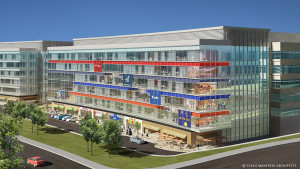If you work in the city, you likely eat lunch every day and give it little thought – unless you’re entertaining a client or have recently become a macrobiotic vegan. Grabbing a salad at Sebastian’s or a sandwich at Cosi is probably as natural to you as blinking. But what if you had to get in your car to get that salad? You might pay more attention to lunch. In fact, you might consider bringing it with you.
Long before denouncing the Seaport’s traffic came into vogue, the gripe du jour was the neighborhood’s lack of amenities.
“Tenants cannot live on Dunkin’ Donuts alone,” people said. And developers listened.
Now the neighborhood boasts steakhouses, upscale Mexican restaurants, an assortment of Barbara Lynch options and the brainchild of an Iron Chef. It’s unlikely anyone in the Seaport is still complaining about lunch. What they are complaining about, though, is traffic and a lack of parking – issues that are slowly creeping into other Boston neighborhoods.
The delivery of 1.6 million square feet of new Seaport office space in the past year means development has swallowed most of the neighborhood’s parking lots. Pair this with the influx of new tenants, and we have quite a problem.
A co-worker recently complained that her time on the wait list for a monthly spot in the Financial District jumped from three to six months. Daily spaces at downtown garages are rapidly becoming extinct. And the cost of a monthly pass is now on par with rent for a high-end apartment in the Midwest.
Acres Of Free Parking
For the past few years, the real estate conversation has centered on office space as a recruitment tool – cool layouts, environmentally friendly design and proximity to bars and restaurants to attract younger workers. 2011 began a wave of migratory leasing activity, bringing dozens of companies from the suburbs to the city in order to attract and retain young and creative talent.
Until recently, the only alternative to congestion and expensive parking was a suburban office park – or, as one client put it, “my dad’s office building.”
With few amenities within walking distance and outdated interiors, the suburbs had become a tough sell – especially for the under-30 and innovation crowds.
Not anymore.
2014 was the year we learned we could have our lunch and eat it too – in the suburbs – where parking is free and mixed-use development now includes walkable urban conveniences. Here at Cassidy Turley, we like the term “urban suburban.” We think it captures the best of both worlds – the accessibility of the suburbs and the amenities of the city.
Flinty New Englanders have shunned the concept of mixed-use development for decades. But 2014 was a pivotal year for us. From Burlington’s Northwest Park, Lynnfield’s MarketStreet, Watertown’s Arsenal Street and Somerville’s Assembly Row to Waltham’s CityPoint and 1265 Main, it’s obvious that 2015 will be the year of the suburban mixed-use development. In anticipation of these transformations, the number of suburban requirements has grown 35 percent in the past 24 months.
It’s safe to say that Downtown Boston will never lose its allure – no matter how scarce or expensive parking becomes. But like Millennials, suburban office workers want it all too – and they’re finally getting it. This is welcome news for those who want to work and play where they live. And park for free.







